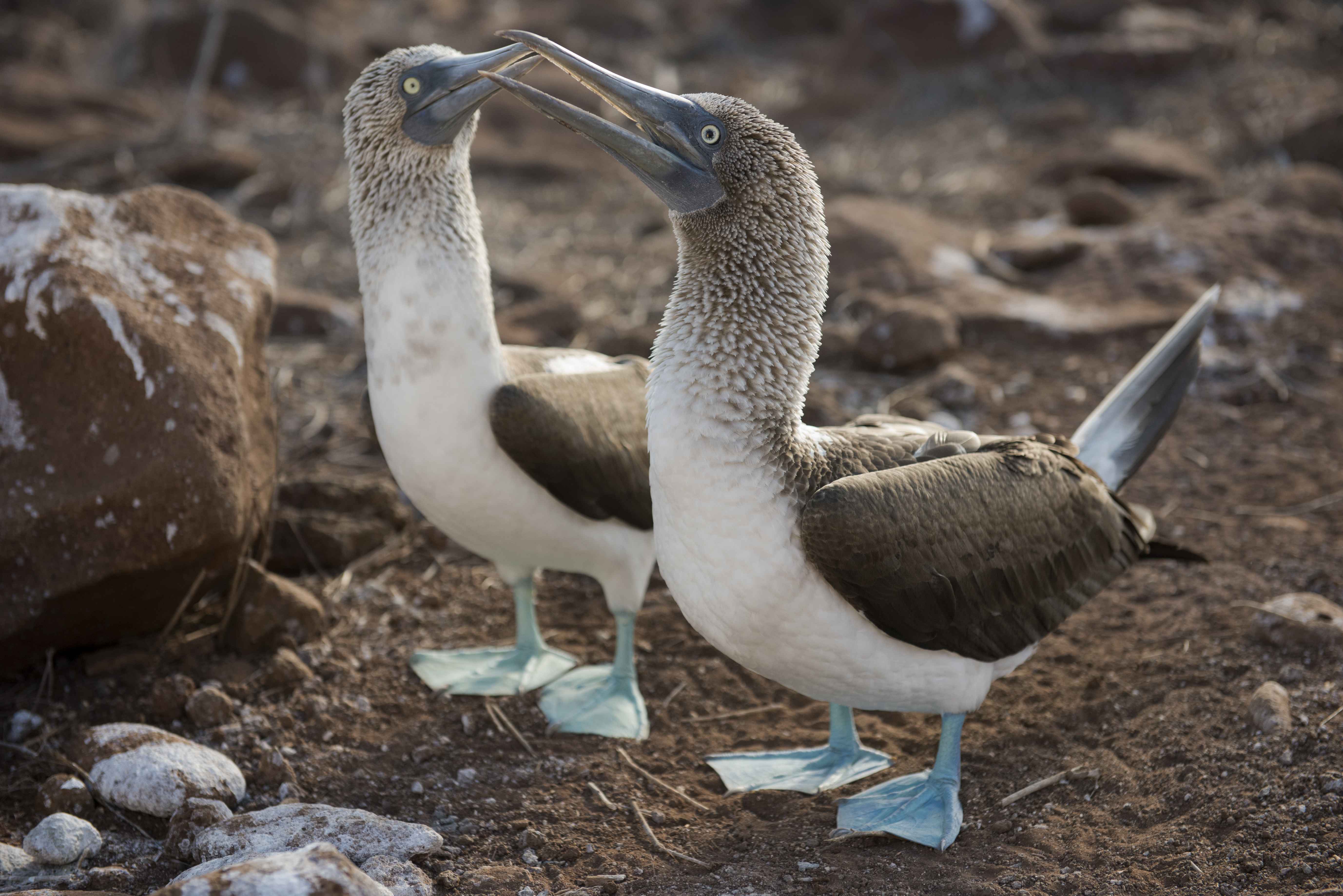Like her sistership, the MY Coral II, has 3 cabin types but is smaller and sails with a maximum of 20 guests. The vessel offers open deck areas with a Jacuzzi to make the best of your relaxing time while cruising the islands. The interiors are thoughtfully designed to resemble a private yacht experience in a cozy ambiance. The restaurant serves delicious Ecuadorian and international cuisine even extending to a BBQ dinner on the open-air Moon Deck. Trips take in the Central, South, East or West areas, with every cruise including excellent wildlife viewing opportunities, an array of activities, land excursions, and views of magnificent scenery. Look out for blue-footed boobies, tortoises, sea iguanas, penguins, and more. Interesting features explored may include lava formations and tubes, cactus forests, and beaches. Each itinerary includes plenty of water activities and Scuba Diving is available. Cruises are available for three, four, seven, and 14 nights. All cruises start and end close to one of the airports, either at San Cristobal or Baltra.
The 11 air-conditioned cabins offer ocean Views and can accommodate twin beds or a full size bed, plus one cabin that can be configured as a triple. There are interconnecting doors suitable for families or friends traveling together. Each cabin includes: safe, entertainment system with LCD TVs, hair dryer, special bedding in each category, and remodeled furniture in each cabin. The voltage is set for 110-220 volts/60 Hz. 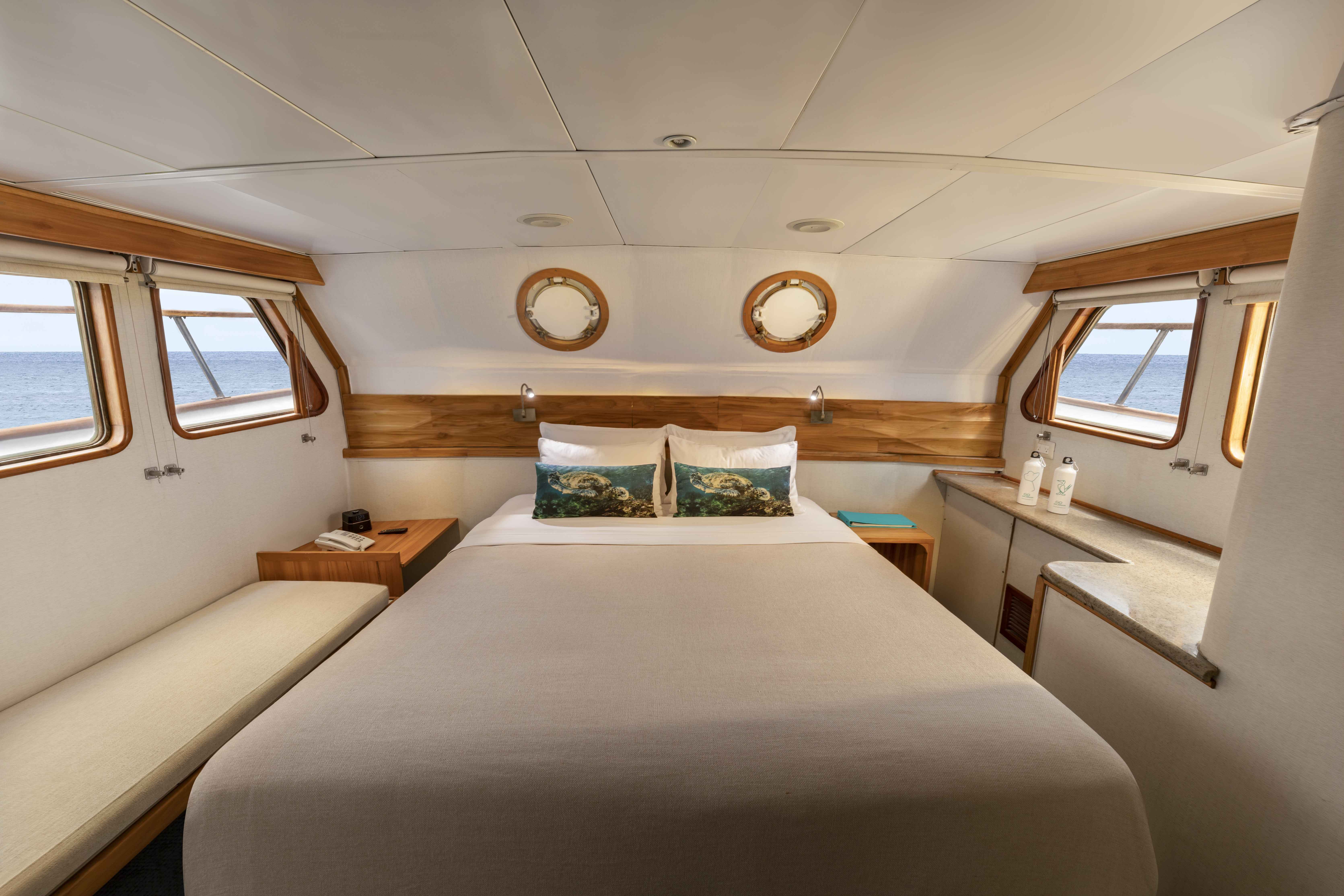
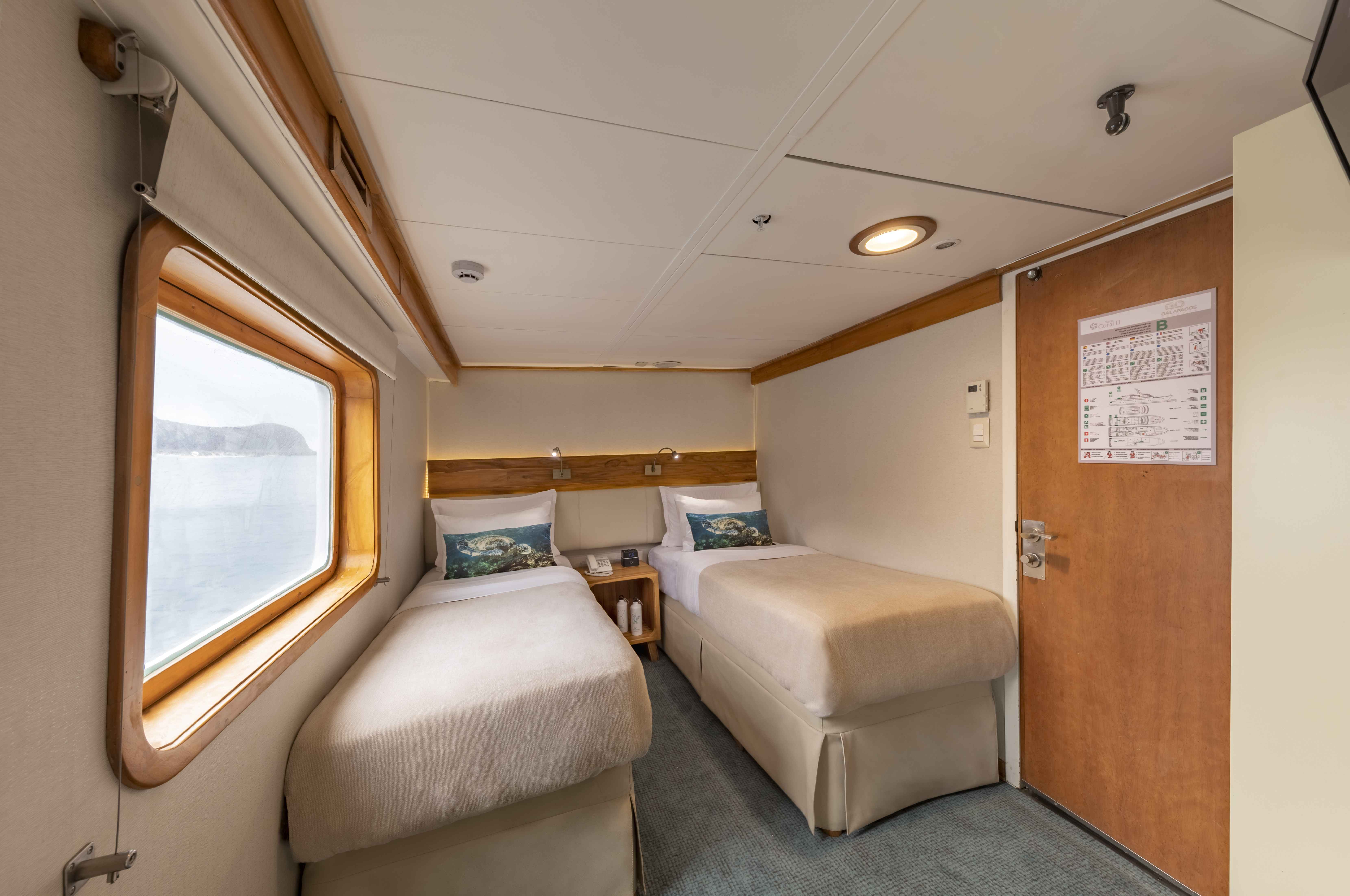
Specifications Coral II
Year of construction: 2005
Type: Motor Yacht
Length: 79fts / 24mts
Beam: 24 ft / 7mt
Capacity: 20 passengers
Accommodation: Sky Deck: 4 Junior Cabins / Earth Deck: 2 Junior Cabins
Sea Deck: 4 Standard Plus Cabins 1 Standard Cabin
All cabins with private bathrooms, hot water and air conditioning
All cabins with private bathrooms, hot water and air conditioning
On Board: Spacious sun deck, buffet area, 2 separate social areas with a well stocked bar, TV and VCR room, stereo, and ice makers
Main engines: Two John Deere 6125SFM75 engines, each one of 610HP
Max speed: 12 knots
Crew: Captain, chef, sailors, and 1 naturalist guide
Safety & Navigation: Ecosounders, Radars EPIRB, VHF, UHF, ISM (International Management Code for the Safe Operation of Ships and for Pollution Prevention)
This Coral Yacht also offers a cozy cruising experience, with only 20 guests, the trip ambiance is of a private yacht style. The onboard and inland activities are great opportunities to bond with fellow travelers, the crew and to share the experiences throughout the trip. The first day on board, our crewmembers will organize a welcome cocktail to celebrate the start of the journey in the Galapagos Islands. Once guests have settled, the adventure begins with two daily visits to the islands. Visiting the islands is a great opportunity to get to know more about this unique destination, animals that have adapted to live on volcanic grounds and crystal clear beaches and are friendly to humans. Picture-perfect sceneries which are home to the overflowing nature of every island.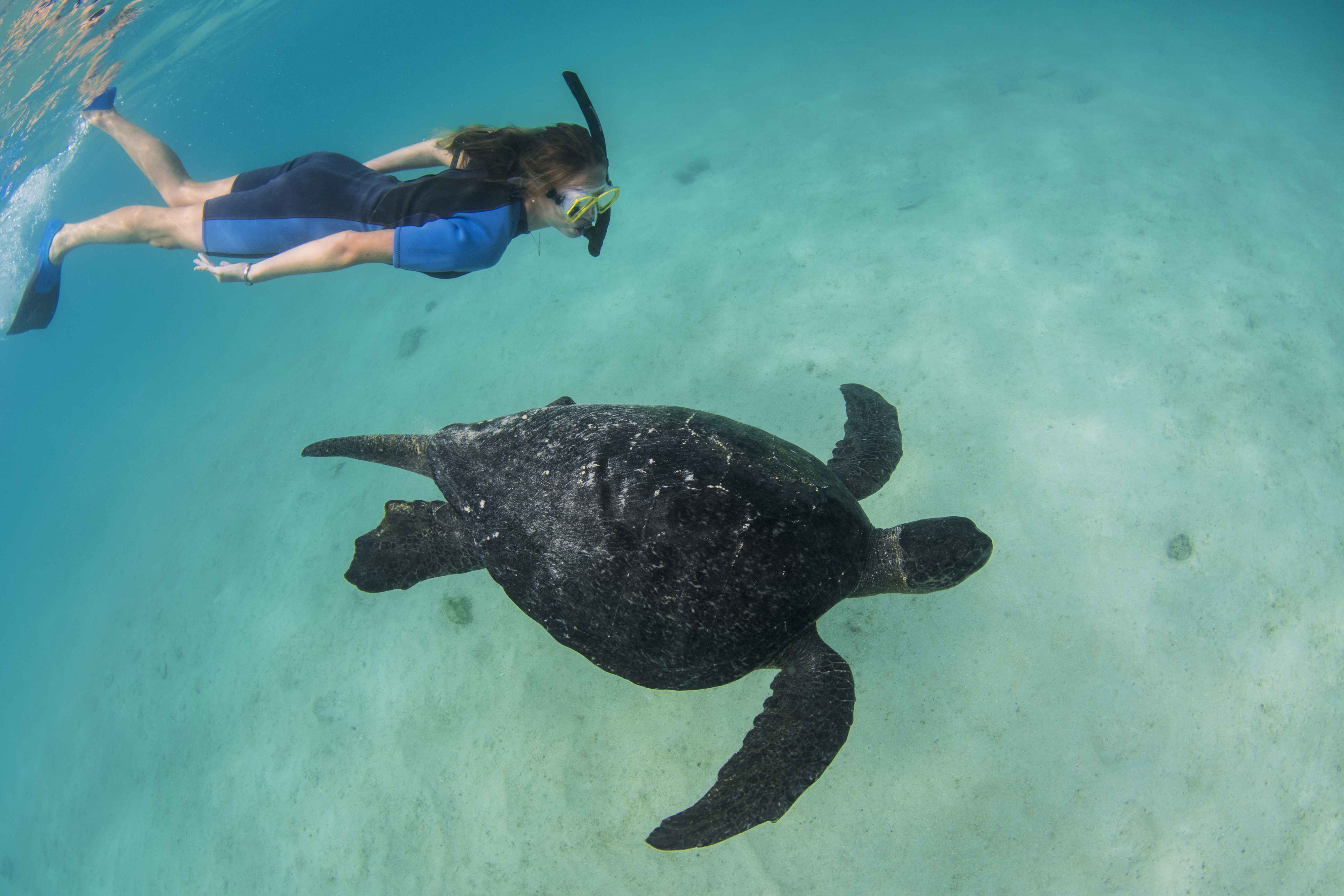
While hiking through the islands, our naturalistic guides will help to unravel the secrets of every visitor site by sharing scientifically, botanical, geographical, and human history stories and facts related to the islands. Our guides are Spanish and English speaking experts in the field, they have gone through extensive training to achieve the certification of the Galapagos National Park and the Go Galapagos knowledgeable and practical training in our guides program. Guides speaking other languages are also available under previous request. They will be able to answer any doubts in the excursions and come along in other optional activities such as dinghy rides, swimming, snorkeling, kayaking, and diving. There is always the option to relax by the shore and enjoy the magnificent Pacific sun too.
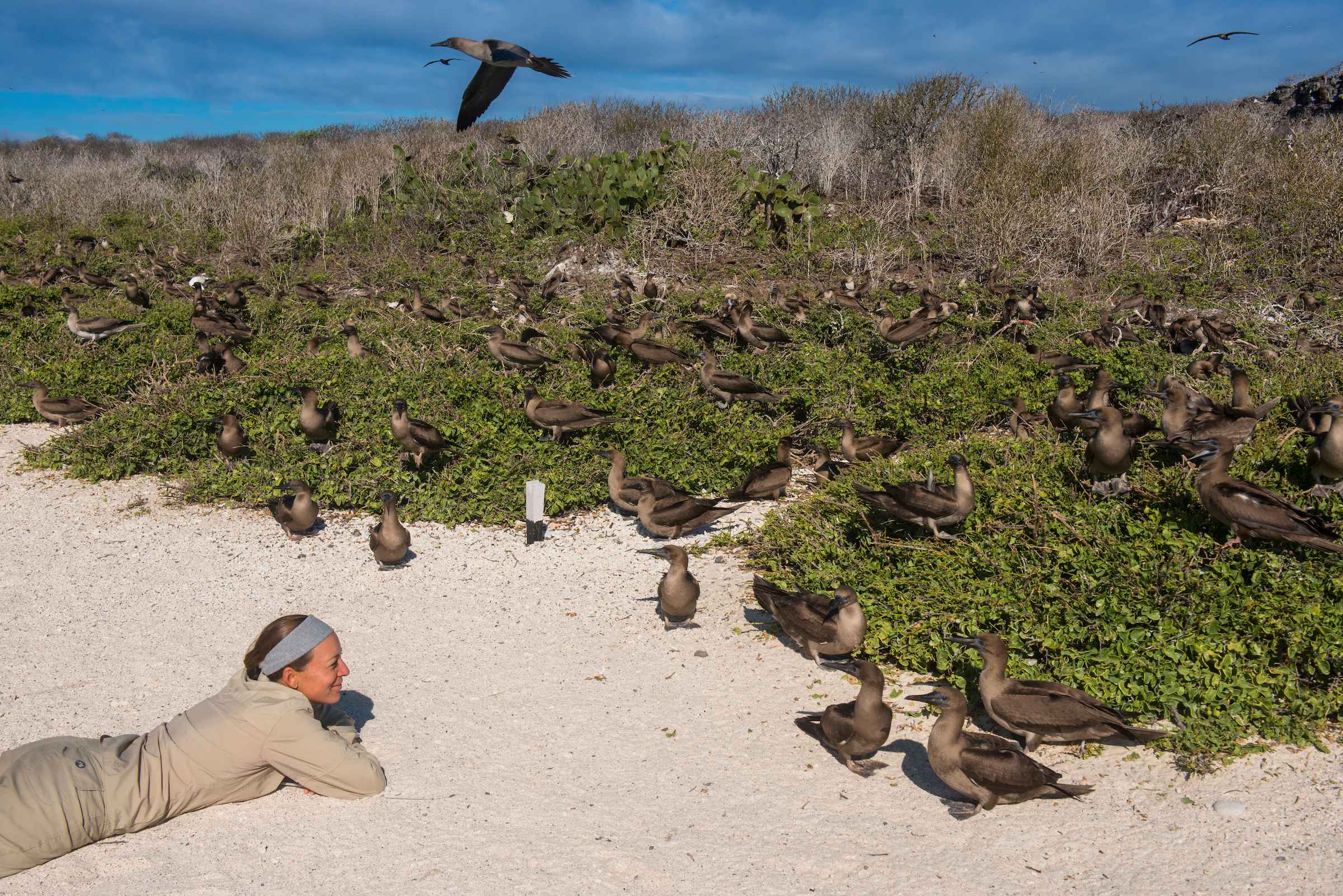
Enjoying the free time aboard, guests can play classic table games, always available on request at the front desk or relax in the open areas of the yachts to enjoy the surroundings and the sun. On a day by the sunset, our chef will surprise guests with a BBQ on the Moon Deck. Enjoying the Galapagos experience at its best, there will be options of great selected cuts and vegetables having the sunset and the sea as the main settings. The cuisine in the yachts follows high standards on local and international dishes to be savored by every palate. Breakfasts and lunches are in buffet-style, while dinner is a-la-carte options. Snacks and beverages will also be offered in the return of every excursion; the most popular is our Ice Cream festival; a refreshing choice with a selection of toppings.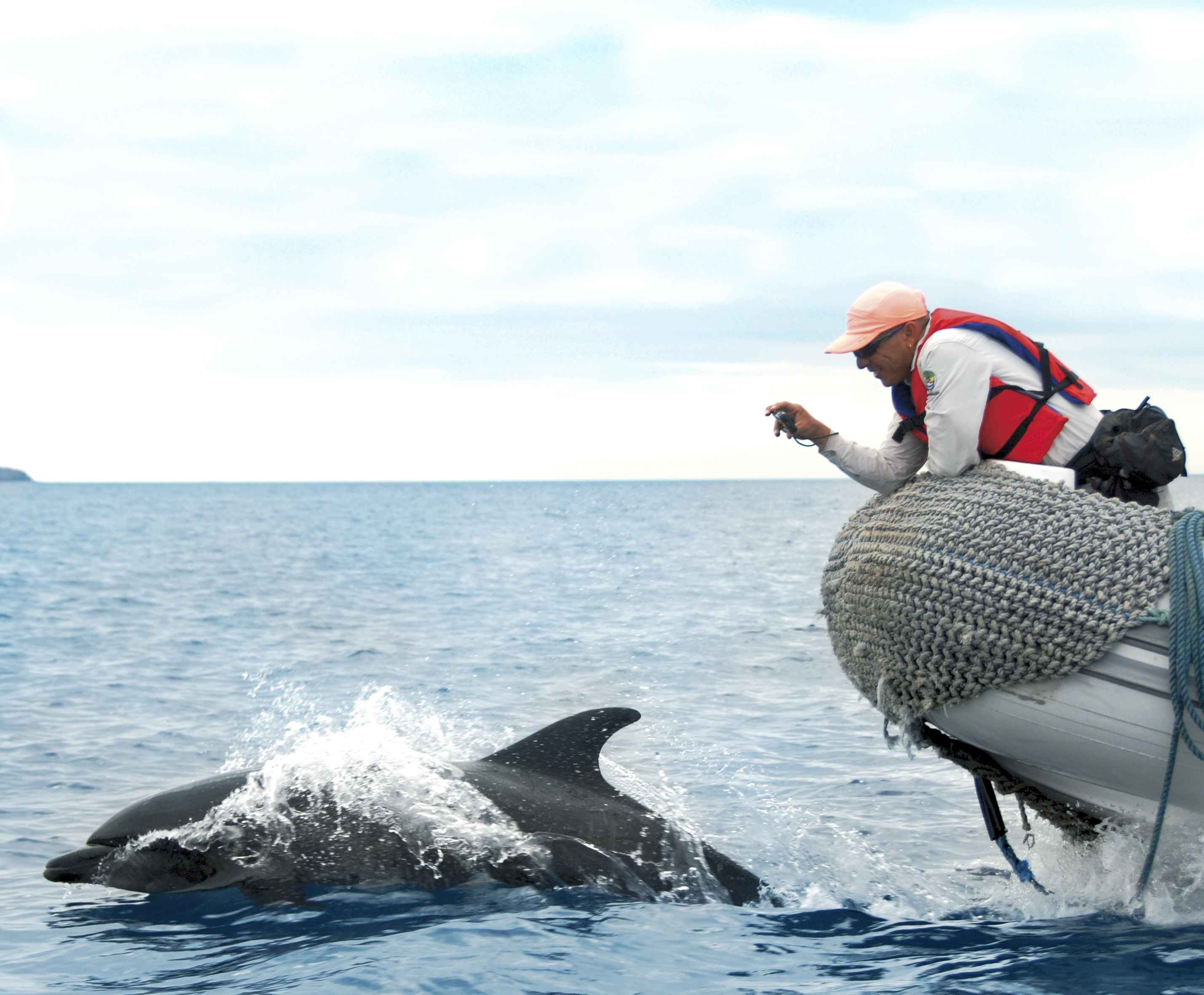
During the evening, guests will have time to relax or join us in our movie nights and popcorn or to listen to stories about how pirates and whalers used the stars to sail to the far corners of the seven seas in our stargazing activity. By the end of the cruise time, our crew will organize a farewell cocktail to wish our guests a safe flight back home. For a lengthy experience, there is the option to extend the cruise time by combining two or more of our itineraries. We can customize your journey from 3, 4, 7, 10 and up to 14 nights so you can cover more islands in the archipelago for a more complete experience in the Galapagos.
A – NORTH CENTRAL ITINERARY (4 days/3 nights)
Day 1 – Sunday
AM – Baltra Airport - Departure from Quito or Guayaquil to Baltra Island (approx. 2½-hour flight). Arriving in the Galapagos, passengers are picked up at the airport by our naturist guides and taken on a ten-minute bus drive to the pier to board the M/Y Coral I or M/Y Coral II.
PM – Charles Darwin Research Station & Fausto Llerena Breeding Center (Santa Cruz Island) - Dry landing. Once home to the famous Lonesome George, the last tortoise of the Pinta race, the breeding and relocation center is named in honor of his long-time guardian. The center is set in the Galapagos National Park Service where various interpretative buildings are available to visit. The grounds, with large stands of native vegetation, are one of the better places to spot some of the seldom seen Darwin’s finches such as the woodpecker, cactus and vegetarian finches.
Difficulty level: easy / Type of terrain: flat / Duration: 1 ½-hour visit
Day 2 – Monday
AM- Dragon Hill (Santa Cruz Island) - Dry or wet landing. Arriving to a small lava dock our first encounters are with marine iguanas that blend-in perfectly to the dark rock. As we walk past large prickly pear cacti we arrive to one end of a long, sickle-shaped, beach with Dragon Hill standing in the distance. Our walk takes us on a circular path, past a shallow lake where flamingoes frequently come to feed. Waders such as stilts, turnstones and sandpipers work the muddy edges frenetically looking for food as we continue inland to a dry, forested habitat where land iguanas nest and burrow.
Difficulty level: moderate / Type of terrain: rocky / Duration: 2-hour walk
PM – Bartolome Island - Dry or wet landing. Considered the most iconic landscape of the entire archipelago the view from the top of Bartolome Island, overlooking the famous Pinnacle Rock and the austere Santiago Island beyond, is well worth the climb up the wooden boardwalk. This volcanic scene has often been likened to a lunar landscape. Our subsequent snorkel here might put us face to face with Galapagos penguins, white-tipped reef sharks and playful sea lions.
Difficulty level: intermediate / Type of terrain: trail made of 372 steps. / Duration: 1 ½-hour walk / 1-hour snorkeling
Day 3- Tuesday
Lying at the heart of the archipelago this dramatic island, with its distinctive red-sand beach, is home to sea lions, mockingbirds, finches, endemic Galapagos doves and vermillion flycatchers. A walk takes us through a forest of palo santo and cacti to a beautiful overview of the bay. Snorkeling here can be excellent, often with large schools of black-striped salemas, sea lions and the ubiquitous turtles.
Difficulty level: easy / Type of terrain: sandy / Duration: 1 ½-hour walk / 1-hour snorkeling / 1-hour dinghy ride
PM – Buccaneers Cove / Espumilla Beach ( Santiago Island) - This is an amazing location, featuring the remains of an eroded shoreline that is home to seabirds, fur seals and the playful sea lions. Its different shapes have been made throughout a process caused by erosion of the waves and the wind. Espumilla Beach is a white-sandy beach in James Bay and is a popular place among visitors. There are mangroves and a small palo santo forest that lead to salty-water lagoons that are home to wading birds like flamingos. In the upper dunes are a nesting site for sea turtles. A good place to snorkel to see rays.
Difficulty level: easy / Type of terrain: white sand / Duration:1-hour walk / 1-hour snorkeling / beach time
Day 4 – Wednesday
Here, we can find four species of mangrove in the extensive tidal lagoon system that stretches for almost a mile inland. During our panga ride through the labyrinth, we will spot many turtles, herons of several species, sharks and rays. The experience is otherworldly and seems to transport us back to the beginning of time.
Difficulty level: easy / Type of terrain: none / Duration: 1-hour panga ride
PM- Baltra Airport - After the visit, passengers will be transferred to the airport to their return flight to Guayaquil or Quito.

B – WEST ITINERARY (5 days/4 nights)
Day 1 – Wednesday
AM- Baltra Airport - Departure from Quito or Guayaquil to Baltra Island (2½-hour flight). Arriving in the Galapagos, passengers are picked up at the airport by our naturist guides and taken in a ten-minute bus drive to the pier to board the M/Y Coral I or M/Y Coral II.
AM – Highlands Tortoise Reserve & Pit Craters (Santa Cruz Island) - Dry landing. In the central highlands of Santa Cruz Island we have our best opportunity to interact at close quarters with totally wild, Galapagos giant tortoises. A short walk among these huge, 600lb, reptiles will also offer the chance for more highland species, especially several species of the famed finches. A visit to the collapsed, twin sinkholes (Gemelos) puts us in a stunning forest of the endemic tree-forming Scalesia. Apart from the dramatic scenery, this area is well known for its diversity of passerine bird species.
Difficulty level: easy / Type of terrain: flat & muddy (depending on season) / Duration: 45-minute drive / 1 ½-hour walk
Day 2 – Thursday
AM- Punta Vicente Roca (Isabela Island) - This is a spectacular visitor site, surrounded by immense cliffs of the eroded volcano. Studded with resting seabirds such as brown noddies and Nazca boobies, we will enjoy them in close proximity from our dinghies. Snorkeling here is superb, with certain species of fish only found in the west of the archipelago. We also have a very real chance of swimming with penguins and potentially a plethora of green turtles.
Difficulty level: moderate / Type of terrain: water / Duration: 1-hour snorkeling / 1-hour panga ride
PM – Punta Espinosa (Fernandina Island) - Dry landing. The youngest island of Galapagos and one of the most pristine in the world. Fernandina is simply the ëmarine iguana capital of the worldí. This desolate volcanic backdrop is home to a huge concentration of these enigmatic reptiles. Incongruously, sharing the same shoreline, we can find the diminutive Galapagos penguins. Here we also have the exciting opportunity to snorkel with marine iguanas feeding underwater, penguins, turtles and the bizarre, endemic, flightless cormorants.
Difficulty level: moderate / Type of terrain: rocky / Duration: 2-hour walk / 1-hour snorkeling
Day 3 – Friday
AM – Urbina Bay (Isabela Island) - Wet landing. At the far end of a long, level hike we arrive at a strange phenomenon where large blocks of coral lie completely exposed after a dramatic geological uplift in 1954. Located at the western base of Alcedo Volcano we hope to run into a few very impressive land iguanas as well as some of the volcanoís endemic Galapagos giant tortoises during the wet season.
Difficulty level: moderate / Type of terrain: flat & rocky / Duration: 1 ½-hour walk / 1-hour snorkeling
PM – Tagus Cove (Isabela) - Dry landing. A well-known hideout and deep water anchorage in the days of pirates, Tagus Cove was also one of the few sites visited by Charles Darwin and the HMS Beagle in 1835. A beautiful hike leads us past an overview of Darwin Lake and on to a stunning volcanic landscape revealing Isabela islandís dramatic northern volcanoes. Once back at sea level the perfect activity is to snorkel along a submerged wall with turtles, lots of fish, penguins and potentially flightless cormorants. You might even be tempted by a panga ride or kayak!
Difficulty level: moderate/demanding / Type of terrain: steep / Duration: 2-hour walk / 40-minute panga ride / 1-hour deep water snorkeling
Day 4 – Saturday
AM – Egas Port (Santiago Island) - Wet landing. The black volcanic sand sets this landing apart from most. It is best known for the dramatic shoreline where we meet a host of species that chose to live between land and sea. Particular among these are the endemic Galapagos fur seals which maintain a small colony at the end of our walk. Other species of note include American oystercatchers, sea lions, waders, herons, lava lizards and even Galapagos hawks. An optional visit takes us to an abandoned salt mine famous in its day for supplying salt to mainland Ecuador.
Difficulty level: moderate / Type of terrain: flat & semi-rocky / Duration: 1½-hour walk / 1-hour snorkeling
PM – Sullivan Bay (Santiago Island) - Wet landing. Although, when viewed from the sea, the site does not look especially interesting visitors are always totally enthralled by the amazing beds of pahoehoe lava from the recent flow on the island. It is a landscape and macro photographer’s dream. The importance of pioneer plants such as the tiny Mollugo will be discussed as we hike over the lava. After our land visit we can enjoy a refreshing snorkel in the company of sea lions, turtles and rays.
Difficulty level: difficult / Type of terrain: flat volcanic lava / Duration: 1½-hour walk / 1-hour snorkeling/beach time
Day 5 – Sunday
AM – Bachas Beach (Santa Cruz Island) - Wet landing. Named for some wrecked World War II barges whose ribs are still visible in the sand this visitor site offers great swimming, a lovely walk along the shore and a visit to a lagoon behind the high tide line with wading birds, marine iguanas and sometimes even flamingoes. The two beaches are also favorite nesting sites for green turtles which often leave tractor-like tracks in the sand.
Difficulty level: easy / Type of terrain: sandy / Duration: 1-hour walk
Baltra Airport - After the visit, passengers will be transferred to the airport for their return flight to Guayaquil or Quito.

C – EAST ITINERARY (4 days/3 nights)
Day 1 - Sunday
AM – Baltra Airport - Departure from Quito or Guayaquil to Baltra Island (2 ½-hour flight). Arriving in the Galapagos, passengers are picked up at the airport by our natural guides and taken to a ten-minute bus drive to the pier to board the M/Y Coral I or M/Y Coral II.
PM – Charles Darwin Research Station & Fausto Llerena Breeding Center (Santa Cruz Island) - Dry landing. Once home to the famous Lonesome George, the last tortoise of the Pinta race, the breeding and relocation center is named in honour of his long-time guardian. The center is set in the Galapagos National Park Service where various interpretative buildings are available to visit. The grounds, with large stands of native vegetation, are one of the better places to spot some of the seldom seen Darwin’s finches such as the woodpecker, cactus and vegetarian finches.
Difficulty level: easy / Type of terrain: flat / Duration: 1½-hour walk
Day 2 – Monday
AM- Mosquera Islet - Wet Landing. This tiny, low lying islet, covered in coral sand, is set between North and South Seymour Islands. It is home to a group of sea lions that come to laze on the soft white sand. It is a good spot to observe shorebirds as well as herons, lava gulls, and boobies. Snorkeling or diving here one can often see sharks, rays, and barracudas.
Difficulty level: easy / Type of terrain: sandy / Duration: 1 ½-hour walk & snorkeling
PM – North Seymour Island - Dry landing. This flat, uplifted, island is an important spot to see both magnificent and great frigatebird males courting the females by clicking, bill-clapping, shuddering and flapping their wings, all while showing off their grossly inflated, bright red, gular pouch. We will also likely see courting blue-footed boobies displaying their unique feet while ‘dancing’ to a prospective mate. Sea lions, swallow-tailed gulls, crashing surf and distant views of the Daphne Islands top off a great visit.
Difficulty level: moderate / Type of terrain: rocky / Duration: 2-hour walk / 30-minute snorkeling
Day 3 – Tuesday
AM – Santa Fe Island - Wet landing. After a fabulous snorkel in the turquoise waters of the protected bay, we may have enjoyed time with sea lions, turtles, reef sharks and spotted eagle rays. Landing onto a sandy beach we are immediately distracted by the abundant sea lions there with us. We begin a walk past a forest of island-endemic giant Opuntia cacti. Here we search for another island-endemic the Santa Fe land iguana, paler than its cousins on other islands. Galapagos hawks and even endemic rice rats are also things to look out for.
Difficulty level: moderate / Type of terrain: rocky / Duration: 1 ½-hour walk / 1-hour deep water snorkeling
PM – South Plaza Islet - Dry landing. Sea lions, swallow-tailed gulls, and land iguanas are all present at the landing site. The small island is covered with a carpet of a red succulent studded with Opuntia cacti. At the cliff edge, we spend time watching birds fly past at eye level in the updraught. These include frigatebirds, flocks of Galapagos shearwaters and of particular note, flights of displaying red-billed tropicbirds. Back at sea level, we once again encounter land iguanas, some of which have hybridized with their resident marine cousins.
Difficulty level: moderate / Type of terrain: rocky / Duration: 2-hour walk
Day 4 – Wednesday
AM – Kicker Rock Circumnavigation & Cerro Colorado Tortoise Reserve (San Cristobal Island) - Kicker Rock can be seen directly from the vessel. In the sea northeast of Puerto Baquerizo Moreno is this ancient and eroded volcanic tuff lava named Leon Dormido or Kicker Rock it is formed by two rocks approximately 148 m, named for its resemblance of a sleeping lion. It serves as home to many of the typical Galapagos sea animals, such as birds, sea lions, blue and Nazca boobies and frigate. With rare sightings of swallow turtle gulls, tropic birds, and pelicans.
Difficulty level: easy / Type of Terrain: water / Duration: 1-hour circumnavigation
Dry landing. In the moist highlands of San Cristobal, we will visit the giant tortoise breeding center “La Galapaguera” to witness the most iconic creature of the archipelago in its various life stages. The tortoises wander in a semi-natural habitat which lends itself to good photographic opportunities. The aim of the reserve is to help restore populations of the threatened San Cristobal tortoise back into the wild. In town, there are shops to purchase local handicrafts and souvenirs.
Difficulty level: moderate / Type of Terrain: sandy / Duration: 40-minute bus drive to the Reserve / 1-hour visit
San Cristobal Airport - After the visit, you will go to San Cristobal Airport for the return flight to Guayaquil or Quito.

D – WEST ITINERARY (5 days/4 nights)
Day 1 – Wednesday
AM- San Cristobal Airport - Departure from Quito or Guayaquil to San Cristobal (2 1/2 hours flight). Arriving in Galapagos, passengers are picked up at the airport by our naturalist guides and taken to the pier to board the M/Y Coral I or M/Y Coral II.
PM – Interpretation Center & Tijeretas Hill (San Cristobal Island) - Dry landing. The interpretation center is full of interesting information and offers the perfect overview to the formation of Galapagos, its significance in the world, threats and conservation efforts. Followed by a hike to Frigatebird Hill (Cerro Tijeretas) we will have great looks at both species of frigatebird, with the bonus of a beautiful view of the bay below.
Difficulty level: easy /moderate / Type of terrain: flat/stairs/rocky / Duration: 1-hour visit / 1-hour walk
Day 2 – Thursday
AM – Cerro Brujo (San Cristobal Island) - Wet landing. From our pangas, as we head to shore, we are first humbled by the immensity of the stunning cliffs of “Sorcerer’s Hill”. We can enjoy simply sharing the beach with sea lions, snorkeling from shore or take a walk to a hidden lagoon where we might spot black-necked stilts, ruddy turnstones, whimbrels and white-cheeked pintails.
Difficulty level: easy / Type of terrain: sandy / Duration: 1-hour walk / 1-hour snorkeling
PM – Punta Pitt & Islet (San Cristobal Island) - Wet landing. Sea lions will greet us as we land on the beach and prepare for our climb to a high point on the steep eroded tuff cone. This is the only place in the islands where we will enjoy the chance to see all three of the booby species in the same place. The red-foots will be perched on the Cordia lutea and small trees, the Nazca’s on the ground near the cliff edge while the blue-foots will be a little further inland. Frigatebirds will be all around and the views are breathtaking.
Difficulty level: demanding / Type of terrain: rocky / Duration: 2½-hour walk/ 40-minute snorkeling or kayaking
Day 3 - Friday
AM – Punta Suarez (Española Island) - Dry landing. One of the highlight visits of the trip. Punta Suarez seems to have everything – a naturalistís paradise. A slew of marine iguanas and sea lions greet us at the landing site from where our walk continues with close encounters of boobies, endemic lizards, gulls and even a dramatic blowhole. The oldest extant island in the archipelago it is our only opportunity to commune with the endemic waved albatross during their breeding season between April and December. With luck, we can watch their complex courtship display.
Difficulty level: demanding / Type of terrain: rocky / Duration: 2½-hour walk
PM – Gardner Bay, Osborn or Gardner Islets (Espanola Island) - Wet landing. One of the most stunning beaches in all of Galapagos. The long, white, sandy beach, lapped by turquoise waters is home to a colony of Galapagos sea lions, indifferent to the humans that walk amongst them. The Hood mockingbirds, endemic to this particular island, will be eager to inspect the visitors and satisfy their innate curiosity. Darwinís finches may also join the throng including the reclusive warbler finch. We can also snorkel here from the beach, in the shallows of the bay.
Difficulty level: easy / Type of terrain: sandy / Duration: 1-hour walk / 1-hour snorkeling
Day 4 - Saturday
AM – Punta Cormoran/ Devil’s Crown/Champion (Floreana Island) - Wet landing. On arriving, the observant visitor will notice that olivine, a volcanic crystal, has proffered a subtle green hue on the dark beach. Our walk takes us past island-endemic Scalesia plants to a large, shallow, lagoon often inhabited by a variable number of shockingly pink greater flamingoes. We continue through a forest of palo santo trees to arrive at a powdery white beach, a nesting area of green turtles. As we paddle barefoot in the shallow water we will spot diamond stingrays and white-tipped reef sharks.This coral-sand beach marks the end of our trail, and we head back to the olivine beach we landed on, to swim or snorkel amongst sea turtles, reef fish, sea lions and, on a good day, white-tipped reef sharks. A small colony of penguins resides on Floreana and can sometimes be observed as well.
One of the favorite snorkeling sites in the islands. Devil’s Crown, an eroded volcanic cone, is home to an abundance of fish and marine animals. We will swim with big schools of yellow-tailed surgeonfish, salemas and creole fish and with luck may spot turtles, spotted eagle rays, parrotfish, and even hammerhead sharks! The jagged ëcrowní is a roosting area for boobies, noddies, tropicbirds, and frigates. A truly magical place to snorkel. We would expect to see here green turtles, harmless white-tipped reef sharks, an impressive diversity and abundance of fish as well as some playful sea lions often approaching very close, itching to show off their prowess in the water. Champion Islet also happens to be the last remaining home of the island-endemic Floreana mockingbird which we may be lucky enough to see from our pangas.
Difficulty level: easy / Type of terrain: sandy & flatDuration: 1-hour walk / 1-hour snorkeling
Post Office (Floreana Island) - Wet landing. A very short walk from the beach leads us to the famous Post Office Barrel. Claimed to have been the first set up in 1793 by Captain James Colnett it remains the oldest functioning ëpost officeí in the Pacific. The system was that whalers and fur-sealers would leave addressed letters in the barrel to be picked up by homeward bound colleagues. In the spirit of maintaining tradition visitors, today will often take letters and hand-deliver them in their home countries.
Difficulty level: easy / Type of terrain: sandy / Duration: 30-minute walk / 1-hour snorkeling
Day 5 - Sunday
AM – Highlands Tortoise Reserve (Santa Cruz Island) - Dry landing. In the central highlands of Santa Cruz Island, we have our best opportunity to interact at close quarters with totally wild, Galapagos giant tortoises. A short walk among these huge, 600lb, reptiles will also offer the chance for more highland species, especially several species of the famed finches.
Difficulty level: easy / Type of terrain: flat & muddy (depending on season) / Duration: 45-minute drive / 1 ½-hour walk
OR (for Extended Cruises only)
Pit Craters (Santa Cruz Island) - A visit to the collapsed, twin sinkholes (Gemelos) puts us in a stunning forest of the endemic tree-forming Scalesia. Apart from the dramatic scenery, this area is well known for its diversity of passerine bird species.
Baltra Island Airport - After the visit, passengers will be transferred to the airport for their return flight to Guayaquil or Quito.